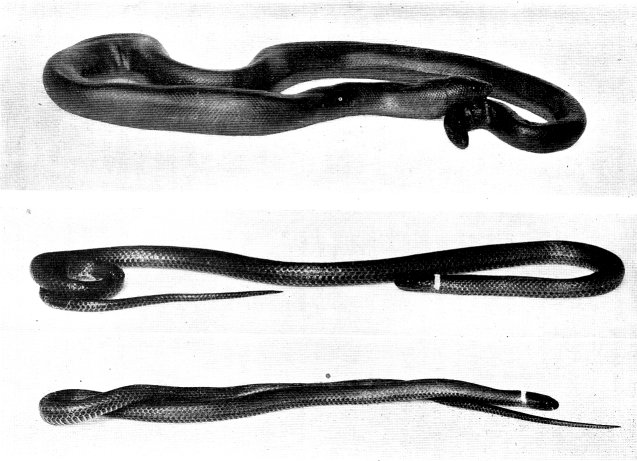
[click to enlarge]
California Academy of Sciences
| Online Library: | Title | Author | California | Geology | History | Indians | Muir | Mountaineering | Nature | Management |
Yosemite > Library > Reptiles & Amphibians > Snakes >
Next: Simplified Key • Contents • Previous: Lizards
The snakes constitute one of the most perplexing divisions of our entire group of backboned animals. Their abundance or scarcity and their remarkable modifications such as loss of legs and specialized heart and lungs, jaws and teeth, tongue and ears—or rather lack of ears—all contribute to the problems that have ever challenged the serious student of herpetology.
While a few snakes of some species are to be found in almost any locality, their abundance or scarcity soon becomes evident to even the experienced snake collector. He soon finds that snakes are abundant in a given locality, not just one species but often many species, while nearby areas are relatively barren. The most logical conclusion is that certain areas have the necessary requirements of food and shelter more favorably developed than others and therefore the snakes congregate there. The denning habit of some hibernating snakes also brings together large numbers each spring and fall when these species are either leaving or returning to the dens.
Perhaps it is the apparent scarcity of snakes that intrigues the average person, for there are many who know little of snake habits. Several of our snakes are active only at night, that is, are nocturnal and do their hunting in the dark. They spend the daylight hours hidden under flat rocks, under logs, or in crevices in the rocks. Even the species that prowl in the daytime seek the shelter and protection of flat rocks or fallen logs.
The snake collector does not “beat the brush” seeking to drive out its reptilian inhabitants, but rather he goes about his work by slowly turning over or looking under all of the flat rocks which might provide a hiding place for the snakes. He is often rewarded by finding several snakes under a single flat rock—a flat rock that could be resting within a few feet of a highway or well traveled trail; yet many people might have passed without ever realizing that several snakes could be so close at hand.
Many centuries ago when snakes gave up their legs to crawl on the ground or into places unavailable to an animal with limbs, they were forced to make numerous adjustments not only in their skeletal structure, but in their internal organs as well. Slenderness and length became necessary in order to progress in the manner now used by snakes, and all are aware that the fastest snakes are the longest and most slender, the stubby and heavy snakes are the slowest. In order to attain this slenderness of body the snakes had to make adjustments in many of their internal organs. Many snakes sacrificed one lung entirely and now have but a single lung, and even that is drawn out into an extremely long and slender organ. The heart of a snake is also very long and slender and unlike the heart of other vertebrates. The liver and gall bladder also show a special adaptation to the space available.
The snakes were forced to swallow their prey entire since they wore without legs or loot to hold it down to tear it apart. This resulted in the development of a peculiarly loosely connected jaw which makes it possible for the snake to swallow entire objects of considerable size. This in turn required the aid of powerful digestive juices that soon came into being. This made it possible for the snake to break down and absorb this quickly secured meal in a more protected spot, and in a leisurely manner.
Because a few species of snakes developed poison glands as an aid or means of quickly subduing their prey and securing their food, and since this poison to a greater or lesser degree affects man, these are classed as dangerous snakes. Unfortunately this has caused a general fear of all snakes. We respect and perhaps fear the wasps and bees because they have stingers and a mild type of poison, but we do not condemn all the insects such as moths and butterflies just because of the bees and wasps. This same line of reasoning should be applicable to the snakes as well, and since we tolerate bees for the honey they produce and the aid they give in fertilizing certain flowers, we should also tolerate the snakes for their aid in controlling the ever present rodents.
Most herpetologists now agree that probably no rattlesnake ever heard itself rattle, for snakes are without external ears. Noise and sound seem to affect snakes very little, but they are very sensitive to vibrations—a most natural specialization since they crawl on the ground. They seem continually to dart out their tongue for it serves to transmit certain materials to a very delicate and highly specialized sense organ. This may aid them in tasting or smelling their way along. The tongue is not an organ of hearing, strictly speaking, nor is it a “stinger” as many people have been led to believe.
A number of the snakes deposit eggs under rocks or logs and then move on, leaving the eggs to hatch and the young to take care of themselves as best they can. Some of the snakes produce their young alive. The common garter snakes often have litters numbering up to thirty-five or forty. All snakes shed their skin periodically, not just once a year, but usually several times a year, and in the case of the rattlesnakes, they get a new rattle every time they shed their skin. It is therefore evident that the number of rattles is not a clue to the age of the rattlesnake, but simply an indication of the number of times it has shed its skin. The more mature rattlesnakes often break off some of the end rattles as they crawl through the rocks and brush, so after the first two or three years the number of rattles means absolutely nothing insofar as age is concerned.
Thirteen snakes have been thus far recorded for Yosemite National Park and two of these are very rare and known from only a few specimens. The garter snakes are probably the most common, racers and gopher snakes are moderately abundant, while the beautifully colored and banded king snakes, seen by many visitors, are regarded as the most attractive.
The rubber snake or rubber boa, which seldom exceeds twenty to twenty-four inches in length, most certainly exhibits few apparent characteristics, either of size or temperament, that would indicate to the casual observer that it is related to the large boas of South America. It has often been called the “two-headed” snake because of its very stubby tail, and it is difficult at first glance to tell “which end is which.” Some observers have been led to believe that the rubber boa takes advantage of this stubby tail, for in the presence of danger or enemies, while it keeps its head low and motionless, it may raise its tail and slowly move it back and forth thereby simulating head movement.
A pair of short spurs or spines which project slightly on either side of the vent appear to represent rudimentary legs or portions of the vestigial pelvic arch. This is one of the few snakes that retain evidence that they once possessed legs.
The rubber boa seems to be well adapted to burrowing in damp and moist soils. Even the bones of the skull are modified, strongly and solidly joined, as are other burrowing forms. The scales are small and very smooth, and the skin seems to be very loose fitting, thereby giving the rubber snake an unusual appearance which makes them readily recognized. Those snakes are uniformly colonel a dull yellowish to greenish brown above and a yellowish white below, and get their common name from their “rubber-like” color and texture. They are sluggish and slow moving and seldom if ever make an attempt to protect themselves. They may be handled easily for they seem never to bite or even try to bite, and they make little effort to pull away. They will on some occasions, however, coil and twist into a rather tight ball, perhaps as a defensive measure. Because of this action they have sometimes been called the “ball snake.”
Although the rubber snake has one peculiarity often associated with the poisonous snakes, that is, the pupil of the eye is arranged vertically, it is absolutely harmless and should never be killed just because it is a snake. We know practically nothing of its life history and breeding habits, so anyone that would make careful observations of this species would be contributing something to science.
The Pacific rubber snake was once considered rather rare in Yosemite National Park, but recent observations seem to indicate that it is at least fairly wide spread even if not abundant. Perhaps its very secretive habits has led to the belief that it is. rare. Specimens in the Museum collection have come from Yosemite Valley, Yosemite Research Reserve, Benson Lake, Tuolumne Canyon, Wawona, and live specimens were observed during the summer of 1944 near Yosemite Point and between Merced and Washburn Lakes.

[click to enlarge] | |
|
From Van Denburgh: The Reptiles of Western North America. Courtesy of the California Academy of Sciences | |
| Upper: PACIFIC RUBBER SNAKE | |
| Lower: CORAL-BELLIED RED-NECKED SNAKE |
The coral-bellied ring-necked snake can be identified with little difficulty, for it is the only snake found in Yosemite National Park that has the single light colored ring around the neck. The ventral surface is orange to reddish, while the dorsal surface is uniformly dull colored.
The ring-necked snake is one of the smallest snakes found in this region, and many adult specimens are no larger than a lead pencil. They seldom reach a length of more than fifteen to twenty inches. They are harmless, will seldom attempt to bite, and are usually easily handled. The scales are smooth and relatively small. The yellowish or orange neck ring stands out distinctly against the dorsal body color which is a uniform olive to bluish or gray. The color and markings of the belly are in sharp contrast to the dorsal coloration, for the underside is an orange red, and the tail is even more brilliantly colored. Because of the red coloration of the underside, these snakes are sometimes called “red-bellied” snakes.
Ring-necked snakes are secretive in habit and are seldom observed in the open. They are often found neatly coiled under flat rocks, old boards, or logs. When suddenly uncovered they may perform most interestingly, for occasionally they will turn belly side up, showing the brilliant under-markings, and then feign death, or perhaps more often they will coil the tail into a tight spring-like spiral that exposes the bright red coloring of the under-surface. It has been assumed by some that this may serve either a protective or warning function.
Recent observations seem to indicate that the ring-necked snakes feed on small tree toads, occasionally on some of the smaller snakes, and on the small or immature lizards of the skink group. It is believed that these snakes lay eggs, but not a great deal is known of the breeding habits of this particular species of snake.
The ring-necked snakes are by no means abundant in Yosemite National Park; however, our Museum records show that they are widely distributed. Specimens have been taken at Bridalveil Fall, Arch Rock Ranger Station, Swamp Lake Research Reserve, Poison Meadow, above Mirror Lake, and on the trail below Vernal Fall. Perhaps careful collecting will prove their scarcity or abundance, and will reveal much that is not now known of their life history and breeding habits.
Rattlesnakes are present in Yosemite National Park, but whether or not we should say they are abundant, common, or scarce, depends on whether we want to exaggerate or minimize their presence. We do not have a large series in our Museum collection; and in view of the fact that the rattlesnake is easily recognized by all, is often killed at once and is later either brought in or reported, it would seem that we dare
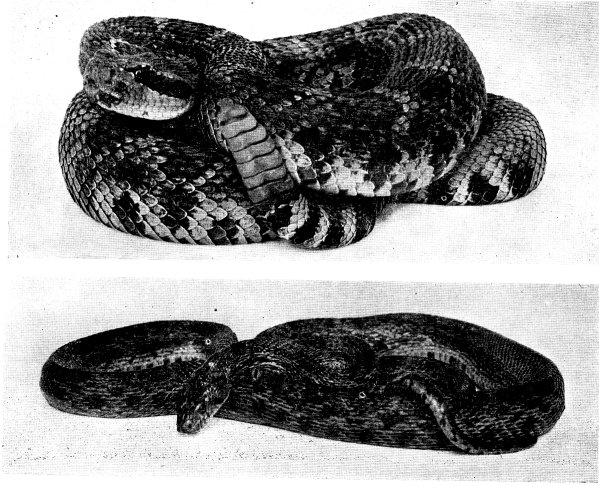
[click to enlarge] | |
|
From Van Denburgh: The Reptiles of Western North America. Courtesy of the California Academy of Sciences | |
| Upper: PACIFIC RATTLESNAKE | |
| Lower: PACIFIC GOPHER SNAKE |
It is perhaps unnecessary to give much of a description of the rattlesnake, for it is usually recognized at a glance because of the triangular shape of the head, the thick, short body, and the presence of the tail rattle. The Pacific rattlesnake, the only species of rattlesnake found in Yosemite National Park, probably does not exceed a length of from three to four feet, but some specimens are unusually robust in body size. They seem to frequent the rocky talus slopes of canyons and valleys, but may also be encountered in more open country or dry grassy meadows.
Rattlesnakes appear to be widely distributed in the Park and some specimens have been taken at elevations that would seem above the normal range of such snakes. Specimens in our collection have been taken in Tenaya Canyon — 6500 feet; Yosemite Valley — 4000 feet; Wawona — 4100 feet; Big Meadows —4400 feet; Hetch Hetchy Valley— 4200 feet; East base of Half Dome— 7800 feet; base of El Capitan—4010 feet; Gentry Ranger Station—5500 feet; and at Miguel Meadows—5200 feet.
The rattlesnake seems to feed on a number of rodents including the various species of ground squirrels and chipmunks, and it appears that their venom is perhaps particularly effective on these small warm-blooded vertebrates. The rattlesnakes do not lay eggs, but produce their young alive; however, broods are usually small and number not more than about a dozen.
There are so many fallacies and folk tales associated with the rattlesnakes that one is hesitant even to enumerate them, but perhaps a few will suffice to cover the salient topics and will thereby encourage those who are interested to do some reading on the subject. A number of these can be briefly contradicted by the following negative facts: — rattlesnakes (1) do not chase people, (2) do not cover a greater distance than their length when striking, (3) can not hear themselves rattle, (4), do not use their poison primarily to frighten people, (5) do not have a rattle for each year of their life, (6) are not always deadly poisonous, (7) can not be made harmless for any length of time by pulling out their fangs, and (8) do not always rattle before they strike. On the other hand the following positive facts are verifiable:—rattlesnakes (1) will die from their own bite, (2) will congregate in large numbers in the winter time in snake dens, (3) will often strike without inserting their fangs, (4) will soon grow new fangs to replace those broken off naturally or pulled out by man, (5) will shed their skin several times a year, (6) will add another rattle teach time they shed, (7) will “go blind” not just once a year but each time they shed their skin, and (8) will, as adults, normally inject more poison than the young.
Everyone is of course interested in the proper treatment for rattlesnake bite. It should be emphasized, however, that “an ounce of prevention is worth a pound of cure.” Hikers will seldom encounter rattlesnakes on the well-traveled trails, but when they leave the trails for exploring on their own they should take certain precautions such as wearing proper shoes, boots or leggings. They should also avoid stepping or placing their hands near cracks or joints in the rocks which might serve as retreats for the rattlesnakes.
Hikers or campers who make a practice of leaving the well-traveled routes should provide themselves with the latest type first-aid kits and should have some training or experience in the proper use of these safety-first aids. Practically all of the modern first-aid kits contain very definite instructions as to their proper use, and these instructions should be carefully studied by those who travel away from the regular trails in rattlesnake-infested country.
The Pacific gopher snake, oftentimes called “bull snake,” is not widely distributed in Yosemite National Park but seems confined to the lower elevations. It is not primarily a snake of the forested and rocky areas but rather of the open grasslands, sandy foothills, and valleys. It takes full advantage of the burrows of gophers, mice and ground squirrels, with many of the original inhabitants of the burrows being taken for food.
The gopher snake is probably given more consideration and afforded more respect than any other of our common snakes. Great emphasis has long been placed on its economic value because of the large number of gophers and other rodents that it destroys, and it is tolerated and sometimes even encouraged by the farmer and ranchman.
These snakes are often rather inactive, especially the adults, and appear somewhat slow and sluggish. When first surprised they will often lie motionless, but if approached and molested they will coil and strike repeatedly, and will at the same time puff themselves up by taking in air which they expel rapidly and thereby make a strange fluttering and hissing noise. In addition many gopher snakes have been observed to vibrate the tail rapidly, and if they happen to be in a pile of dead or dry leaves, the result is usually a rustle or “rattle” sounding very much like a rattlesnake. This entire performance is usually all bluff, for if a person continues to advance and either places his foot on the snake or holds it down with a stick, it will often become rather docile in just a few minutes and can even be picked up and handled with ease. These snakes are well supplied with short but strong, sharp recurved teeth and they make a nasty wound if allowed to bite. Although they are not poisonous they should be handled carefully and never given an opportunity to bite, for such wounds may very easily become infected.
The adult gopher snakes are probably the largest snakes found in this region, for they are rather bulky in addition to the fact that they sometimes reach a length of three to four feet. The tail is long and tapers to a point. This is very different from the rattlesnake which has a short blunt tail. The gopher snakes all have a peculiarly enlarged scale (rostral) on the tip of the snout that is extended upward and backward, apparently an adaptation for burrowing. This will distinguish them from all other snakes in Yosemite National Park. The general body color of gopher snakes is a dark ocher yellow but they are marked on the back with a series of dark brown saddle marks or blotches and with small dark spots along the sides. The pattern of marks on the back is often mistakenly assumed to be “diamond” shaped and at first glance are sometimes confused with the markings of the rattlesnake.
The gopher snakes deposit a small number of eggs which are placed either under rocks, in shallow burrows which they themselves make, or in burrows of gophers or ground squirrels.
The Pacific gopher snake has been taken in Yosemite National Park in Yosemite Valley, at Arch Rock Ranger Station, Miguel Meadows, and near the hose of El Capitan.
The western blue racer and the California striped whipsnake are quite unlike in general appearance, but since they belong to the same genus they are not treated separately. They are typical of our racers and whipsnakes, being very long and slender and capable of moving rapidly. They are adapted not only for speed on the ground, but they seem to climb readily in shrubs and trees. Their food supply is extremely varied for they take insects, toads, frogs, lizards, small mammals, young birds in the nests, and even bird eggs. Contrary to popular belief, they do not kill by constriction or “squeezing” their prey.
In Yosemite National Park the adult western blue racer may be readily distinguished from the adult California striped whipsnake because the former is uniformly colored a bluish brown, and without any indication of lateral or dorsal striping, while the latter is dark brown and with two very distinct lateral light lines that extend the full length of the body. The young of the western blue racer display a color pattern very unlike the adult. They are blotched, spotted and barred, and are often confused with young gopher snakes or night snakes by the casual observer. The striped whipsnake may be distinguished from the other commonly striped snakes (garter snakes) because the latter nearly always possesses a mid-dorsal light line in addition to the lateral
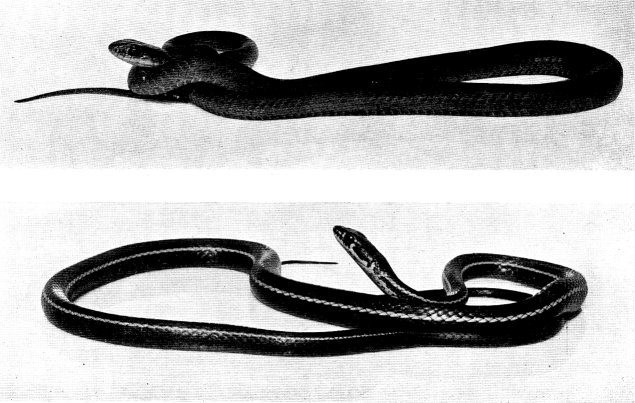
[click to enlarge] | |
|
From Van Denburgh: The Reptiles of Western North America. Courtesy of the California Academy of Sciences | |
| Upper: WESTERN BLUE RACER | |
| Lower: CALIFORNIA STRIPED WHIPSNAKE |
The western blue racer is often called the yellow-bellied racer because the underside of the body is plain yellow. They reach a length of slightly over four feet. They deposit fairly large numbers of eggs that hatch in two to three months.
Because of their habit of moving with the head often lifted some distance off the ground, they have no doubt been responsible for such snake fallacies as the hoop snake story and the idea that these snakes chase people. Perhaps the snakes that “chased” people were just overly inquisitive and let their curiosity cause them to move forward, perhaps toward or more often after the observer, with their heads well raised off the ground. Their curiosity satisfied, they will usually “turn tail and run.”
The California striped whipsnake has a very long tail that tapers to a point, and the scalation so resembles the old fashioned braided whip that the common name has been applied. This whipsnake seldom exceeds four and a half feet in length. Their food is varied but they seem to catch an unusually large number of skinks. On a few occasions they have been observed killing and eating rattlesnakes.
Both the racers and whipsnakes prefer the more open brushy hillsides and dry grassy meadows. In Yosemite National Park the western blue racer, which seems to be the most abundant, has been taken in Yosemite Valley, El Capitan Meadow, Pate Valley, and near Swamp Lake. The California striped whipsnake has been taken in Miguel Meadows, on Henness Ridge, in Poison Meadows, and near Cascade Creek.
Everyone is familiar with the garter snakes for they are not only widely distributed, but individuals exist in greater numbers than any other group of snakes in North America. Their striped characteristics are recognized by all, and since they frequent ponds, streams, and lakes, the hiker, fisherman, and the picnicker are always aware of their existence.
The garter snakes are generally accepted as harmless and not a great deal of heed is given them. Some forms will bite viciously, however, and their sharp recurved teeth will produce some bad scratches. They should be handled carefully and never allowed to bite for their teeth may carry decayed food or other infectious materials. Some of the garter snakes have the bad habit of giving off a very ill smelling and nauseating secretion from specialized anal glands whenever they are picked up, and when they whip their bodies and tails around and smear this material over themselves it most certainly discourages one’s fondling them. In the wild this may afford them some measure of protection from enemies.
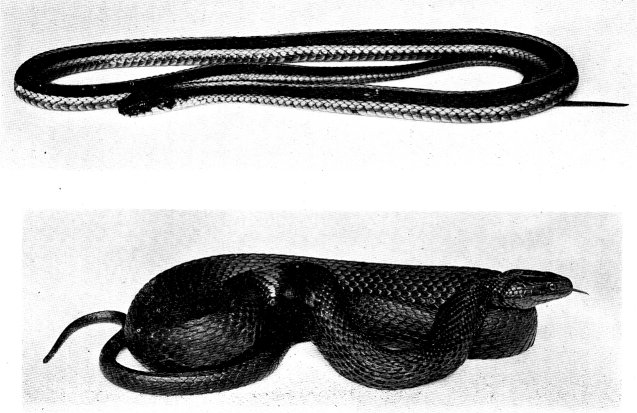
[click to enlarge] | |
|
From Van Denburgh: The Reptiles of Western North America. Courtesy of the California Academy of Sciences | |
| Upper: CALIFORNIA RED-SIZED GARTER SNAKE | |
| Lower: SIERRA NEVADA GARTER SNAKE |
One of the interesting characteristics of the garter snakes is the fact that they do not lay eggs, but produce their young alive, and furthermore, they sometimes produce litters of considerable size with adult averages of some species running thirty to forty per litter. It is no wonder then that the garter snakes are so abundant. These snakes are perhaps as much responsible as any of the snakes for the fallacy that snakes swallow their young. The story is usually “proven” when the observer claims to have later killed the snake and discovered the young inside. What he did not realize was that he had merely revealed the presence of a number of unborn young that were not in the stomach, but in the oviducts of the female.
The three species of garter snakes found in Yosemite National Park show sufficient distinctive characteristics and occupy different ranges and zones so that they may usually be identified without too much difficulty; however, this does not hold true for the country as a whole, and the garter snakes constitute a rather difficult group to study.
The California red-sided garter snake may be recognized by the presence of red spots along either side, in addition to the distinct lateral and mid-dorsal light lines or stripes. These snakes are not large and seldom exceed two feet in length. They are not abundant in the Park and are apparently limited to the lower elevations. They may reach the lower end of the Valley, but most of our records are from the vicinity of Swamp Lake and Miguel Meadows.
The mountain garter snake occupies a higher range, and is most abundant at Tuolumne Meadows, Benson Lake, Yosemite Research Reserve, Lukens Lake, Cold Canyon, Harden Lake, and Turners Meadow. This snake possesses three very distinct light lines, two lateral and one mid-dorsal, but there are no red side spots as in the red-sided garter snake. The mountain garter snake seldom exceeds two feet in length.
The Sierra Nevada garter snake differs from the two other garter snakes in that its stripes are less distinct, and often the dorsal stripe is broken into a series of spots, or may actually be missing. The sides are barred with alternating dark to black spots. Most of the garter snakes are at home near ponds, lakes, and streams, however, this garter snake actually takes to the water and may be found in and along swiftly moving streams. It is approximately the same length as the two striped garter snakes, but appears to be a bit more robust in general body proportions. The Sierra Nevada garter snake has been taken along the Merced River in Yosemite Valley, near Merced Luke, Pate Valley, Swamp Lake, and Miguel Meadows.
The garter snakes all secure their food close to their pond, stream or lake habitat, and they take a large number of toads, frogs, salamanders, and occasionally fish eggs and small fish.
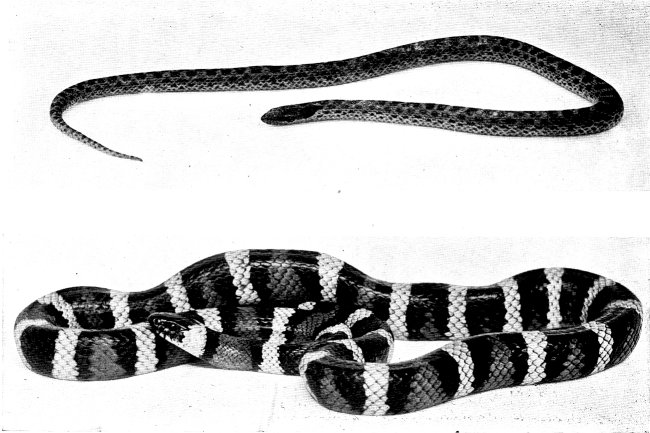
[click to enlarge] | |
|
From Van Denburgh: The Reptiles of Western North America. Courtesy of the California Academy of Sciences | |
| Upper: SPOTTED NIGHT SNAKE | |
| Lower: SIERRA CORAL KING SNAKE |
The spotted night snake is another of the small snakes present in Yosemite National Park. Adults seldom reach a length greater than fifteen to twenty inches. They are no much larger around than a lead pencil. The general color is a dullish-white covered with innumerable tiny specks of brown to black, but there are two mid-dorsal rows of alternating black spots, often actually touching, and with two or more rows of lateral side spots, the lowermost quite small. The nape of the neck is crossed with a wide black band that extends forward through the eye. The belly is whitish and spotless. The pupil in the eye of the spotted night snake is interesting for it is arranged vertically like that of some poisonous snakes.
The size of this snake renders it relatively harmless to man, although some of the rear teeth are enlarged, and there is some indication that these snakes have a poison that is effective on small lizards. Or one occasion a night snake was observed to strike a small Sceloporus lizard, grasping it around the body a short distance back of the front legs. The snake quickly coiled around the lizard and appeared to exert some constriction. They were separated in a few minutes, but with some difficulty. Tho lizard remained motionless and seemed completely paralized, although it continued to breathe. It was rolled over and placed on its feet but it made no effort to move. The snake made no attempt to eat the lizard, and the next morning, some twelve hours later, the lizard was dead and in exactly the same position and location in the jar as when last observed the night before.
The spotted night snake seems to be extremely rare for specimens are usually found only when uncovered in road building or ditching operations, or when turning over flat rocks. One exception, however, was a specimen observed by the aid of a flash light about 10:00 o’clock at night. It quickly vanished under a flat rock, but was pulled out with the aid of a small wire. When held in the hand it would attempt to strike and to pull away, and it was especially strong and muscular for so small a snake. Even after three or four days in a small jar, during which time it was handled on several occasions, it still exhibited its vicious belligerent attitude.
The common name “night snake” is indicative of its habits, for it seems to be active only at night. It is, therefore, doubtful if many people will ever see specimens of this snake except in museum collections. Not a great deal is known of its food preferences or breeding habits.
In Yosemite National Park it has been taken from under a flat rock near the base of El Capitan at an elevation of 4000 feet, and along the Big Oak Flat road by members of a road crew working at an elevation of 5000 feet.
Since some people object to calling a snake beautiful, we shall be considerate, but on the other hand we must say that the Sierra coral king snake, often called mountain king snake, is one of the most attractively and vividly colored snakes in Yosemite National Park.
The series of red, white, and black bands that appear to encircle this snake, especially in specimens that have only recently shed their skin, never fail to bring forth exclamations of surprise and wonder even from the most avowed “snake haters.” It is the only snake in Yosemite National Park with distinctive red, white and black color bands; therefore it is easily recognized by everyone. It should be pointed out, however that an occasional specimen is found with the red almost entirely absent. This may make it difficult to distinguish at first glance from the California king snake. The scales of this snake are very smooth, not keeled as in the garter snakes, and this perhaps adds to the brilliancy of the colors, especially in specimens that have only recently shed their skin.
The Sierra coral king snake seldom exceeds a length of from twenty-five to thirty inches. It seems to inhabit the rocky talus slopes along either side of Yosemite Valley and specimens in our collection have come from Mirror Lake, Tenaya Canyon, Cascade Creek and from various localities in the Valley itself.
These snakes are very quiet and docile, especially in captivity, and they may be picked up and handled with ease, for only rarely will they attempt to bite. Their gentleness seems to belie the fact that in the wild they are often predacious and feed not only on lizards, but on other snakes as well, and not even hesitating to occasionally destroy a rattlesnake. Some observers believe the king snakes are immune to the poison of the rattlesnake.
Unfortunately the Sierra coral king snake is often confused with the poisonous coral snake (Micrurus) which is never found in this region. This is due not only to the common name, but also because of the banded color pattern as well. Because of this misunderstanding many people kill the Sierra coral king snake whenever one is found. It should be pointed out, however, that they are not only harmless, but in addition are of considerable economic value because of the large number of rodents they destroy. In captivity they have been observed feeding on skinks and small Scelopous lizards.
The California king snake, so conspicuous because of its pattern of black and white rings, is one of the most interesting of our larger snakes. It is commonly quite gentle and docile and does not resent being handled. It makes one of the most easily kept of all reptile “pets” because it feeds so readily in captivity. It will usually take mice, gophers or small ground squirrels as soon as their presence is observed by the snake.
This king snake is a very good bluffer, however, and will often show fight when first cornered. It will strike out in a threatening manner and in addition will cause the tail to vibrate very rapidly. When this occurs in a pile of dry leaves or twigs the result is a faint buzz or rattle which is enough like the sound made by a rattle-snake to cause one to move forward with caution.
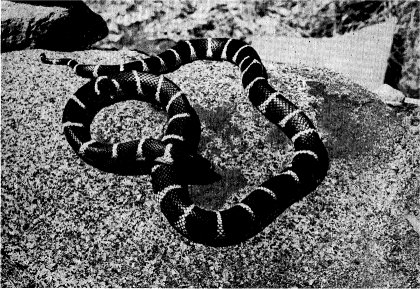
[click to enlarge] |
| N. P. S. Photo by Anderson |
| CALIFORNIA KING SNAKE |
The food habits of this king snake cause it to have more than ordinary economic importance. It not only destroys obnoxious rodents such as mice, gophers and ground squirrels —occasionally it may even destroy rattlesnakes—but it shows no hesitancy in destroying some of the other beneficial snakes. Its cannibalistic habits are well known to all snake collectors, for many a specimen has been “lost in the bag” during field collecting expeditions.
This particular species of king snake has a most interesting and variable color-phase in certain areas in California, the rings sometimes being replaced by a broad median longitudinal stripe, but thus far all specimens taken in the Yosemite region hold true to the black and white ring pattern.
The California king snake sometimes reaches a length of over forty inches. A specimen caught in the Museum wildflower garden in the summer of 1945 measured 41 1/2 inches in total length. This specimen seemed to be particularly large and robust for most specimens observed only average from 30 to 36 inches in length, and many are rather slender.
The scarcity of specimens in the Museum collection would tend to indicate that this species is rather rare within the boundaries of the Park. Information gathered and observations made during the summer of 1945 seem to prove such is not the case, for at least six or eight specimens were reported that season; however, all were observed near or on the floor of Yosemite Valley, so that the distribution of this species may be somewhat limited.
The sharp-tailed snake is the smallest snake found in Yosemite National Park. The few specimens observed indicate that it is about as large as a pencil and seldom exceeds a length of twelve or fourteen inches. It is considered the rarest of all our Yosemite snakes, for we have only two specimens in our study collection, and records of only two others being taken in the Park. One specimen in our collection was picked up along the roadside near the Big Trees Lodge in the Mariposa Grove, and the other was found under an old pile of magazines in a dark closet of one of the unoccupied buildings at Wawona. Another specimen was found near the Merced Grove by workers engaged in Ribes eradication, but unfortunately this specimen was later lost. The fourth specimen was discovered by workers in the Ribes eradication camp at
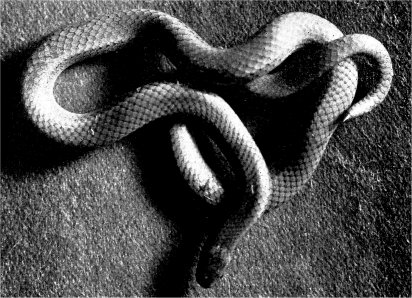
[click to enlarge] |
| N. P. S. Photo by Anderson |
| SHARP-TAILED SNAKE |
The sharp-tailed snake is rather stout for its length, and the tail quickly tapers to a sharp point. A specimen kept alive and under observation for nearly two months is described as follows: The color above is a pinkish orange grading toward a pinkish brick red. The dorsal scales are all uniformly colored, with only a faint trace of flecking with darker shades. A lateral dark line is present on either side involving the second, third and lower half of the fourth scale rows. The ground color of these scales is nearly white, but they are shaded dark due to the many fine black to slate flecks or blotches.
The underside is a creamy white but with a transverse black band across each belly plate. A dark stripe runs from each nostril back through the eye and extends a short distance beyond the last labial scales.
The sharp-tailed snake is of especial interest because the tail terminates very abruptly and the scales are modified into a rather sharp spine, hence the common name. This snake is no doubt partly responsible for the myth about the snake with a “stinger” in the end of its tail. There is some evidence that this sharp-pointed tail may be used in a defensive manner. Other observations seem to indicate that it may have a special use in burrowing, for no doubt these snakes are nocturnal and burrow-inhabiting forms.
Practically nothing is known of the breeding or food habits of this small snake, nor of its distribution within the Park.
PRINTED BY
CROWN PRINTING & ENGRAVING CO.
FRESNO, CALIFORNIA
![]()
Next: Simplified Key • Contents • Previous: Lizards
| Online Library: | Title | Author | California | Geology | History | Indians | Muir | Mountaineering | Nature | Management |
http://www.yosemite.ca.us/library/reptiles/snakes.html